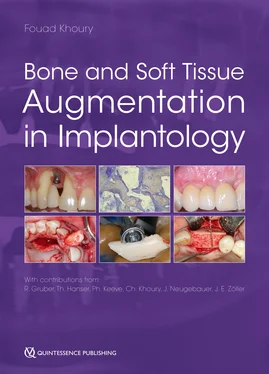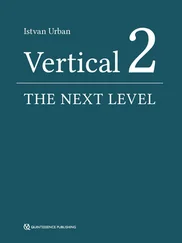Bone resorption also occurs after tooth extraction, as reported in canine models 5and clinical cases, 104and when the facial bony wall is thin it even disappears, probably due to the lack of vascular supply. 26The questions are as exciting as they are important: 1) Why are transplanted autographs resorbed? 2) Why does this resorption occur partially but not completely, depending on the size and anatomy of the autograft? 3) Why is it difficult to predict the extent of resorption?
There are certainly many reasons for bone resorption – some are known (e.g. the influence of muscle activity), while others are as yet unknown. In case of human sinus augmentation with pure autogenous grafts, around 40% of bone volume is lost within 6 months, probably through the respiratory pressure on the sinus mucosa covering the grafted and non-mechanical resistant trabecular bone, 31,47,101similar to a canine model. 102In alveolar cleft patients, transplanted iliac bone showed comparable bone resorption rates of less than 40% within 6 months. 39,136On a cellular level, the resorption of autologous bone chips by osteoclasts within 1 week is particularly obvious in the pig mandibular defect mentioned above. 100It seems that the resorption of transplanted bone that undergoes necrosis is prone to resorption – similar to local bone areas, with microcracks that undergo fatigue damage and are replaced by remodeling. 107
There must be at least one mechanism that controls the resorption of the transplanted bone. One possible explanation could be the function of osteocytes, which are ubiquitously present in the bone, forming a coherent network. 15Osteocytes can control the formation of boneresorbing cells by expressing RANKL, 89,138,139a central agonist of osteoclastogenesis. 118In addition, there is increasing evidence from mouse research that dying osteocytes significantly promote osteoclastogenesis. 120The resorption of alveolar bone upon tooth extraction, implant placement, and early stages of graft consolidation after bone transplantation may also be associated with osteocytes. In all cases, the bone tissue is separated from the blood vessels, and therefore the oxygen and nutritional supply of the osteocytes by passive diffusion is limited or even impossible. Consequently, osteocytes die, and, by a molecular mechanism, promote the expression of RANKL by the adjacent osteocytes that, in turn, can initiate osteoclastogenesis. 65,66Molecules released by dying osteocytes can also increase the sensitivity of osteoclast progenitors to RANKL via a C-type lectin receptor. Importantly, unloading-induced bone loss also requires the dying osteocytes to enhance bone resorption via their expression of RANKL. 17Accordingly, bone resorption, presumably also in dentistry, is bound to dying osteocytes and does not progress uncontrolled. However, it is reasonable to suggest that dying osteocytes can not only transiently push osteoclastogenic resorption, but also the reparation process, through new bone formation as a normal physiologic reaction of remodeling. Thus, the initial boost of bone resorption that occurs at implant sites 131and upon bone grafting 100is followed by the attraction of osteogenic progenitor cells that become bone-forming osteoblasts on the surface of the host bone, the autografts, and also on biomaterials, including dental implants. 131
Elegant preclinical studies in mouse models support the hypothesis through experiments in which the apoptosis of the osteocytes were analyzed after the preparation of an implant bed, e.g. drilling tools create a zone of dead and dying osteocytes around the osteotomy 29that is increased as a function of the insertion torque. 19The pharmacologic suppression of apoptosis can also reduce bone atrophy upon extraction in a rat model. 105Thus, the strategy exists to develop low-invasive drill designs that initiate low heat and mechanical friction, with the overall goal of preserving osteocyte viability. 1,28In a bovine femora, test drills can reach 47°C, particularly after repeated use, 20which is similar to experiments performed with polyurethane foam blocks, 43a temperature that causes osteocyte damage and RANKL expression in a rat model. 37Cutting energy is converted into heat. 80Bone chips produced by drilling 80presumably follow the dying osteocytes – RANKL expression axis and are removed by osteoclasts before the osteoconductive properties come into play. It therefore seems relevant to pay special attention to atraumatic procedures when placing implants, extracting teeth, and probably also removing bone grafts, with the overall aim of maintaining the vitality of osteocytes. For example, at the time of implant insertion in free fibula or iliac crest bone grafts, most of the biopsies showed partial or total necrotic bone. 58There is also limited atrophy of free fibular grafts after mandibular reconstruction. 57,110The question is raised: How much vital bone is necessary for the survival of the graft?
1.5 Osteoconductive characteristics of autografts
According to the textbooks, autologous bone has the following properties: “osteoconductive, osteogenic, and osteoinductive.” 3Osteoconductive is the term used to describe the property of new bone being able to form on the surface. 3Therefore, osteoconductive materials can not only serve as a guide rail for bone regeneration in a defect of critical size, but also in bone augmentation. It is also a term, albeit unusual, for the property of implant surfaces that allows for the deposition of new bone without the formation of a fibrous layer. 3,34Osteoconductivity therefore first requires a surface. Once the transplanted bone has been partially resorbed, the remaining bone surface again becomes osteoconductive. 100Transplanted bone that remains after the initial resorption phase serves as a guide splint. Clinically, it is therefore common to dimension autologous bone, taking into account partial resorption. The reason why autologous bone clearly allows more bone formation than bone substitutes in the first weeks after transplantation in a pig mandibular defect 16remains a matter of speculation, but it is not particularly surprising that osteoblasts and their mesenchymal progenitors like the mineralized surface that they have produced themselves. In summary, the property osteoconductive can be confirmed for autologous bone through histology.
1.6 Osteogenic properties of autografts
Autografts contain viable osteoprogenitor cells, in contrast to allografts and bone substitutes of xenogeneic and synthetic origin. By definition, osteogenic means that the cells brought along during transplantation actively participate in bone formation, i.e. osteogenic precursor cells of the mesenchymal line differentiate into osteoblasts after transplantation and form new bone. Numerous in vitro studies have shown that osteogenic cells can be generated from explant cultures of bone grafts, particularly from trabecular but also from cortical bone. 56,115The key experiment that proved osteogenicity related to transplantation at ectopic sites. This research took place in the 1970s, when Gray and Elves transplanted isografts from the ilium 52and femur diaphysis, 53e.g. into the back of rats. They showed bone formation after 2 weeks, mainly originating from the transplanted endosteal and periosteal cells. Once the cells were removed by enzymatic digestion or through boiling, the osteogenic capacity was nil, suggesting that the osteocytes could not replace the cells on the surface and that the bone matrix alone could not induce bone formation.
In a xenogeneic transplantation model, 5 mm 3of human morselized cancellous bone from the proximal femur was transplanted into immunodeficient mice that received radiation, and depletion of macrophage and natural killer cells. Consistently, after 8 weeks, new bone was produced by human bone cells rather than from the induction of host mesenchymal cells into mouse osteoblasts. 13Bone transplants, however, underwent resorption and necrosis in untreated immunodeficient mice, considering that macrophages could developed into osteoclasts. 13Also, in a goat model, ectopic transplantation of 1 cm 3of femur condylar corticocancellous bone was transplanted in the paraspinal muscle. Both the block grafts and the respective bone chips showed ectopic new bone formation after 12 weeks. Upon freeze thawing, block grafts maintained a weak osteogenic potential, while the respective bone chips were resorbed, 75probably because only a few osteogenic cells can survive under such conditions. 114Preclinical research in goats showed that it requires a well-nourished environment for the transplanted osteogenic cells to contribute to bone formation. 74Mouse models further revealed that perivascular cells located within transcortical channels contributed to osteoblast formation and bone tube closure in a cortical bone transplantation model. 97,123
Читать дальше












